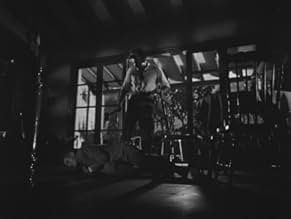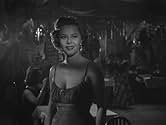NOTE IMDb
7,6/10
975
MA NOTE
Un journaliste déchu s'associe à un immigré hongrois pour créer une fausse école de journalisme par correspondance.Un journaliste déchu s'associe à un immigré hongrois pour créer une fausse école de journalisme par correspondance.Un journaliste déchu s'associe à un immigré hongrois pour créer une fausse école de journalisme par correspondance.
- Réalisation
- Scénario
- Casting principal
- Récompenses
- 2 victoires au total
Otto Webber
- Noriega
- (as Otto Weber)
George Hilton
- Hombre en redacción
- (as Jorge Hilton)
Avis à la une
THE BITTER STEMS is a 1956 Argentine Film Noir and is one of two new releases from Flicker Alley and the Film Noir Foundation that showcase two "lost" movies from 1950s Argentina. It was based on a best selling Argentine novel and is on AMERICAN CINEMATOGRAPHER's list of the 100 Best Photographed Films of all time. The cinematographer, Ricardo Younis, was a pupil of the legendary Gregg Toland (CITIZEN KANE) while Fernando Ayala was emerging as one of Argentina's top directors. After being acclaimed on its initial release, it disappeared for many years before being discovered at a private collector's home. Restoration was done at the UCLA Film & Television Archive.
The story concerns a disillusioned journalist (Carlos Cores) who joins forces with a Hungarian immigrant (Vassili Lambrinos) to create a fake journalism correspondence school so the Hungarian can bring his family to Argentina. It all starts well with the money rolling in and 2/3 going to bring the family over but soon the journalist thinks he is being cheated after the appearance of a woman who is not a family member. It is then that he takes matters into his own hands with tragic results. In addition to solid performances and moody photography, BITTER STEMS features an early score from celebrated composer Astor Piazzola.
Thanks once again to Flicker Alley for continuing their ongoing Film Noir Series in partnership with "Noircheologist" Eddie Muller and to his Film Nor Foundation for rescuing THE BITTER STEMS from oblivion. The DVD/Blu Ray combo comes with a 23 page booklet that is loaded with photos and information. Other extras include a filmed introduction on the movie with Muller, a conversation with Argentine archivist Fernando Martin Pena, and a profile of composer Astor Piazzola. Finally there is an optional commentary from film historian Imogen Sara Smith. An absolute must have for fans of Film Noir...For more reviews visit The Capsule Critic.
The story concerns a disillusioned journalist (Carlos Cores) who joins forces with a Hungarian immigrant (Vassili Lambrinos) to create a fake journalism correspondence school so the Hungarian can bring his family to Argentina. It all starts well with the money rolling in and 2/3 going to bring the family over but soon the journalist thinks he is being cheated after the appearance of a woman who is not a family member. It is then that he takes matters into his own hands with tragic results. In addition to solid performances and moody photography, BITTER STEMS features an early score from celebrated composer Astor Piazzola.
Thanks once again to Flicker Alley for continuing their ongoing Film Noir Series in partnership with "Noircheologist" Eddie Muller and to his Film Nor Foundation for rescuing THE BITTER STEMS from oblivion. The DVD/Blu Ray combo comes with a 23 page booklet that is loaded with photos and information. Other extras include a filmed introduction on the movie with Muller, a conversation with Argentine archivist Fernando Martin Pena, and a profile of composer Astor Piazzola. Finally there is an optional commentary from film historian Imogen Sara Smith. An absolute must have for fans of Film Noir...For more reviews visit The Capsule Critic.
"Los tallos amargos" is a great example of film noir released out of USA. Following the tradition of classic Hollywood (the most brillant time in the history of cinema), this picture tell us the story of a poor journalist who, trying to make easy money, begins to work with an hungarian inmigrant. They start a fake journalism school and soon their pockets are full of dirty money. When the journalist begins to have suspects on your partner, the plot will become most than interesting. A perfect movie, a very good story. A picture that looks like any american film of that time. 9 out of 10.
EXTRA: When the A.F.I. chose the 100 bests cinematography of all time, this argentine movie was in the list among titles like "Citizen Kane" (!)
EXTRA: When the A.F.I. chose the 100 bests cinematography of all time, this argentine movie was in the list among titles like "Citizen Kane" (!)
The Argentinian movie Los tallos amargos (1956) was directed by Fernando Ayala.
Carlos Cores portrays a journalist who forms an unlikely alliance with a Hungarian immigrant, played by Vassili Lambrinos. They open a fraudulent journalism correspondence school. All goes well until mistrust and jealousy intrude.
The acting in the movie is outstanding, and we are treated to a film score by the great Argentinian composer Astor Piazzolla.
We saw this movie at the wonderful Dryden Theatre at the George Eastman Museum in Rochester. Congratulations to the Dryden for screening this film in its original 35mm format. Los tallos amargos was considered lost until a 35mm negative was found and restored by the UCLA Film & Television Archive.
This movie might not be for everyone, but if you love film noir, this is the movie for you.
The acting in the movie is outstanding, and we are treated to a film score by the great Argentinian composer Astor Piazzolla.
We saw this movie at the wonderful Dryden Theatre at the George Eastman Museum in Rochester. Congratulations to the Dryden for screening this film in its original 35mm format. Los tallos amargos was considered lost until a 35mm negative was found and restored by the UCLA Film & Television Archive.
This movie might not be for everyone, but if you love film noir, this is the movie for you.
I've always searched great but unknown films noirs from outside USA, in England of course, but also France, Italy, Scandinavia, Egypt, South America and especially Argentina.
I just discovered this Argentinian noir movie, and it's a must. A real tough brainstorming in music, cinematography, script, acting. A constant crescendo creepy atmosphere about a man possessed by nasty war II nightmares. Very intelligent use of music by Astor Piazolla , wonderful cinematography by Ricardo Younis (Gregg Tolland's student). And what an ending, never seen such a cynical one. Bravo.
I just discovered this Argentinian noir movie, and it's a must. A real tough brainstorming in music, cinematography, script, acting. A constant crescendo creepy atmosphere about a man possessed by nasty war II nightmares. Very intelligent use of music by Astor Piazolla , wonderful cinematography by Ricardo Younis (Gregg Tolland's student). And what an ending, never seen such a cynical one. Bravo.
Very dated movie done --part of it-- as expressionistic 1930s German cinema, part as realistic 1950s European neo realism, all mixed up with a very Argentinian way of interpreting the brief and blunt dialogs throughout the whole movie.
The story is quite interesting. It could have been superbly interesting if the script could have been fully developed going deeply into the main character psychology and motives for his behavior instead of the bumpy way shown here so abruptly from one scene to the next (unless I saw a faulty copy with missing scenes).
Our tortured main character motivations for what he does, as seen in this version, is totally incomprehensible, since he has no real proof to take such a drastic measure to solve the dilemma that tortures his feverish mind.
The photography may be the best asset in this film, done in black and white with a very impressive atmosphere, dark and oppressive almost all the time.
The soundtrack is also very good, following the black mood of the story very precisely and to the point.
But the whole feeling disclosed here, either about the city, its people or our protagonists is nowadays as removed from us as a Christopher Columbus ship could be as incongruous standing next to an atomic submarine.
The story is quite interesting. It could have been superbly interesting if the script could have been fully developed going deeply into the main character psychology and motives for his behavior instead of the bumpy way shown here so abruptly from one scene to the next (unless I saw a faulty copy with missing scenes).
Our tortured main character motivations for what he does, as seen in this version, is totally incomprehensible, since he has no real proof to take such a drastic measure to solve the dilemma that tortures his feverish mind.
The photography may be the best asset in this film, done in black and white with a very impressive atmosphere, dark and oppressive almost all the time.
The soundtrack is also very good, following the black mood of the story very precisely and to the point.
But the whole feeling disclosed here, either about the city, its people or our protagonists is nowadays as removed from us as a Christopher Columbus ship could be as incongruous standing next to an atomic submarine.
Le saviez-vous
- AnecdotesAs discussed on TCM's Noir Alley by host Eddie Muller in July 2021, a screening of the restored 35mm print of this film was held on behalf of the Film Noir Foundation at the Museum of Modern Art (MoMA) in New York City in February 2016, and shockingly in attendance was 90 year-old Vassili Lambrinos, who, after years of living in various parts of the globe, was living just a few blocks from MoMA. Lambrinos had never seen the film on the big screen nor with an audience before that screening, having seen the film only in an editing room before then.
- Citations
Andreani: You make him infallible. You have an old passion; the need to obey.
Alfredo Gaspar: Passion to obey?
Andreani: To be a subordinate.
- ConnexionsReferenced in Preserving Memory: Fernando Martín Peña on Argentine Cinema (2024)
Meilleurs choix
Connectez-vous pour évaluer et suivre la liste de favoris afin de recevoir des recommandations personnalisées
Détails
- Date de sortie
- Pays d’origine
- Langue
- Aussi connu sous le nom de
- The Bitter Stems
- Lieux de tournage
- Plaza de Mayo, Buenos Aires, Argentine(Gasper and Jarvis walk in the Plaza de Mayo and look at the Cabildo.)
- Société de production
- Voir plus de crédits d'entreprise sur IMDbPro
- Durée
- 1h 30min(90 min)
- Couleur
- Mixage
- Rapport de forme
- 1.37 : 1
Contribuer à cette page
Suggérer une modification ou ajouter du contenu manquant




























